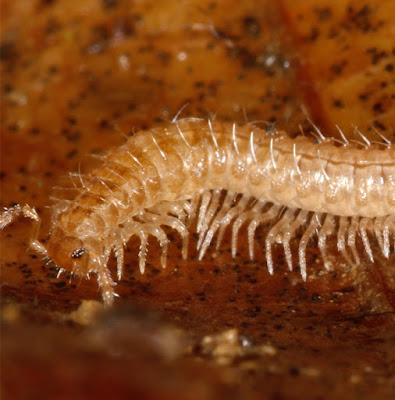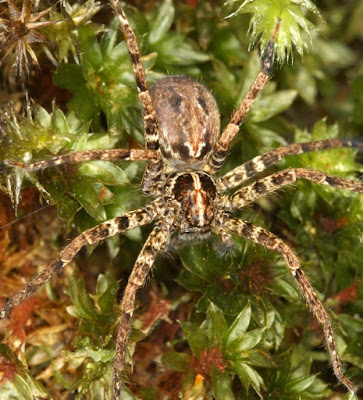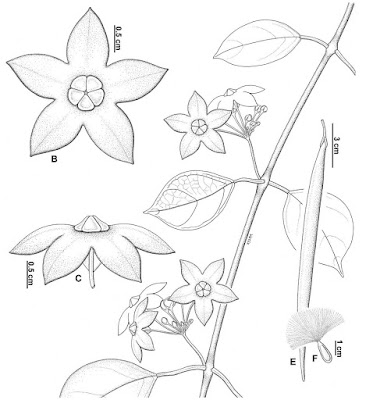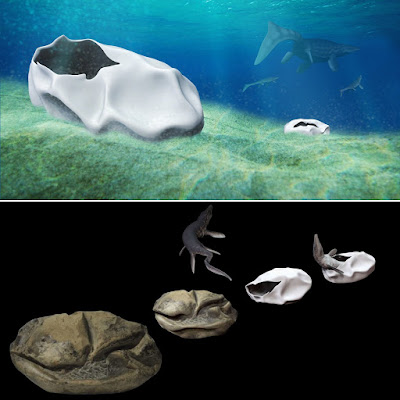[Most Recent Entries] [Calendar View]
Thursday, June 18th, 2020
| Time | Event | ||||
| 6:59a | [Diplopoda • 2020] Haasea Verhoeff, 1895 (Chordeumatida, Haaseidae)—A Genus of Tumultuous History and Chaotic Records—Redefinition, Revision of Taxonomy and Geographic Distributions, with Descriptions of Two New Species from Austria and Serbia
Abstract In this paper we revise the chordeumatidan genus Haasea Verhoeff, 1895 for the first time and describe two new species viz., H. gruberi sp. nov. and H. makarovi sp. nov. discovered in Austria and Serbia, respectively. A new terminology is proposed to standardize the description of the gonopod structures in the genus. Type material obtained from several institutions was examined and documented herein, whereby lectotypes are designated. We clarified the taxonomic status of a few taxa and consider the species H. norica (Verhoeff, 1913) and H. guidononveilleri Makarov, 2008 as a junior subjective synonyms of H. cyanopida (Attems, 1903) and H. vidinensis (Strasser, 1973a), respectively. The following subspecies or varieties, viz., Orobainosoma filicis ossiacum Verhoeff, 1939b, Orobainosoma flavescens vornatscheri Verhoeff, 1935, Orobainosoma hungaricum orientale Tabacaru, 1965, and Orobainosoma inflatum var. aspidiorum Verhoeff, 1929 are here regarded as junior subjective synonyms of their nominal taxa. The taxonomic relationships within the genus Haasea are discussed and an identification key to its 17 species is presented, based on number of body segments and gonopod structures. Maps showing species occurences based on historical and recent records are presented to understand their respective geographic ranges. H. flavescens is now deleted from the list of species in Croatia, Bosnia and Herzegovina, Slovenia and Italy as these records were based on misidentified material. H. inflata is deleted from the fauna of Bosnia and Herzegovina, whereas H. hungarica is newly recorded from Austria, Serbia and Slovenia. Keywords: Myriapoda, Haasea gruberi sp. nov., H. makarovi sp. nov., new synonymies, lectotypes, identification key, gonopod structures, SEM, distribution maps, taxonomy, millipedes, Central Europe, the Alps, the Carpathians, the Balkans Dragan Antić and Nesrine Akkari. 2020. Haasea Verhoeff, 1895—A Genus of Tumultuous History and Chaotic Records—Redefinition, Revision of Taxonomy and Geographic Distributions, with Descriptions of Two New Species from Austria and Serbia (Diplopoda, Chordeumatida, Haaseidae). Zootaxa. 4798(1); 1-77. DOI: 10.11646/zootaxa.4798.1.1 | ||||
| 7:23a | [Arachnida • 2020] Forty-seven New Species of Sinopoda (Sparassidae: Heteropodinae) from Asia with A Considerable Extension of the Distribution Range to the South and Description of A New Species Group Abstract Up to current knowledge, the spider genus Sinopoda Jäger, 1999 is distributed in South-, East- and Southeast-Asia. New material treated in this paper include new records from Brunei, India, Indonesia, Thailand and Vietnam. Forty-seven new Sinopoda species are described: S. aenyk spec. nov. (female; Laos), S. arboricola spec. nov. (male, female; Malaysia), S. assamensis spec. nov. (female; India), S. bifurca spec. nov. (male, female; China), S. bispina spec. nov. (male; Myanmar), S. caeca spec. nov. (female; Laos), S. chiangmaiensis spec. nov. (male, female; Thailand), S. cornuta spec. nov. (male, female; Indonesia), S. deminutiva spec. nov. (male; Laos), S. emei spec. nov. (female; China), S. empat spec. nov. (male; Malaysia), S. flexura spec. nov. (female; Indochina), S. hainan spec. nov. (male; China), S. hanya spec. nov. (male; Malaysia), S. incisura spec. nov. (female; China), S. inthanon spec. nov. (male; Thailand), S. kalaw spec. nov. (female; Myanmar), S. kambaiti spec. nov. (male; Myanmar), S. kamouk spec. nov. (female; Laos), S. kieo spec. nov. (female; Laos), S. kinabalu spec. nov. (male; Malaysia), S. konglor spec. nov. (female; Laos), S. kyee spec. nov. (female; Myanmar), S. lebar spec. nov. (female; Indonesia), S. longicymbialis spec. nov. (male, female; Thailand), S. lot spec. nov. (female; Thailand), S. maculata spec. nov. (female; Malaysia), S. mat spec. nov. (female; Vietnam), S. matang spec. nov. (male, female; Malaysia), S. nanphagu spec. nov. (female; Myanmar), S. parva spec. nov. (male; Malaysia), S. phathai spec. nov. (female; Thailand), S. phiset spec. nov. (female; Thailand), S. phom spec. nov. (male, female; Thailand), S. reinholdae spec. nov. (female; Malaysia), S. rotunda spec. nov. (female; China), S. ruam spec. nov. (female; Thailand), S. silvicola spec. nov. (male, female; China), S. sulawesia spec. nov. (male, female; Indonesia), S. tawau spec. nov. (female; Malaysia), S. thieu spec. nov. (female; Vietnam), S. tibang spec. nov. (female; Indonesia), S. tilmanni spec. nov. (male, female; Malaysia), S. tralinh spec. nov. (female; Vietnam), S. tuber spec. nov. (female; Malaysia), S. unicolor spec. nov. (female; Thailand) and S. wayala spec. nov. (female; China). The female of S. exspectata Jäger & Ono, 2001 and the males of S. scurion Jäger, 2012 and S. steineri Jäger, 2012 are described for the first time. Males of S. tengchongensis Fu & Zhu, 2008 and S. triangula Liu et al., 2008 and females of S. crassa Liu et al., 2008 and S. licenti (Schenkel, 1953) are redescribed. In addition to the okinawana-group, a second species-group is diagnosed, the chiangmaiensis-group, which includes S. chiangmaiensis spec. nov., S. lot spec. nov. and S. phathai spec. nov. All three species occur in north-western Thailand. Twenty new species are described from caves, some of which have distinct cave adaptations: S. caeca spec. nov. is the second known eyeless huntsman spider, S. kamouk spec. nov. has two remnants of eyes without pigments, S. empat spec. nov. has four remnants of eyes without pigmentation and S. tralinh spec. nov. has all eight eyes but without pigments. All other new species herein described have eight functional eyes. Keywords: Araneae, huntsman spiders, taxonomy, cave adaptation, Southeast Asia Elena Grall and Peter Jäger. 2020. Forty-seven New Species of Sinopoda from Asia with A Considerable Extension of the Distribution Range to the South and Description of A New Species Group (Sparassidae: Heteropodinae). Zootaxa. 4797(1); 1-101. DOI: 10.11646/zootaxa.4797.1.1 | ||||
| 7:50a | [Botany • 2020] Heterostemma carnosum (Apocynaceae, Asclepiadoideae) • A New Species from Papua New Guinea
Abstract The new species, Heterostemma carnosum is described, illustrated and compared with the similar species Heterostemma dalzellii. The two species differ in peduncle, pedicel and corolla size as well as in leaf shape. Keywords: Ceropegieae, Crater Mountain, Papuasia
Heterostemma carnosum Rodda, sp. nov. Similar to H. dalzellii Hook., as both species have flowers with a rotate corolla, papillose inside, and a compressed-globose sessile corona. They are separated by the length of the peduncle (10–25 mm in H. carnosum, vs < 5 mm in H. dalzellii), pedicel (12–15 mm in H. carnosum vs < 7 mm in H. dalzellii and flower (corolla 2.5–3 cm diameter in H. carnosum vs < 1.5 cm in H. dalzellii). Etymology. The specific epithet refers to the fleshy leaves and corolla (Latin carnosus = fleshy) that is an unusual feature in a genus that usually has species with thin leaves and corollas. Distribution and ecology. Heterostemma carnosum is only known from one specimen collected East of Haia Village, within Crater Mountain Wildlife Management Area, Papua New Guinea. Based on the label information, Heterostemma carnosum was collected in hill forest with some anthropogenic disturbance at the margins of an old garden. Michele Rodda. 2020. Heterostemma carnosum (Apocynaceae, Asclepiadoideae), A New Species from Papua New Guinea. Taiwania. 65(3); 326-328. taiwania.ntu.edu.tw/abstract.php?type=ab | ||||
| 8:01a | [Ichthyology • 2020] Resurrection of Ophichthus zophistius (Anguilliformes: Ophichthidae), with A Revised Diagnosis of O. altipennis
Abstract Pisoodonophis zophistius Jordan and Snyder 1901 is redescribed as a valid species of Ophichthus Ahl 1789 based on 46 specimens including the holotype. Although this name has been synonymized under Ophichthus altipennis (Kaup 1856), the former can be distinguished from the latter by a relatively acute snout (vs. strongly acute), presence of irregular obscure bars on the body (vs. bars absent), 11–13 predorsal and 61–63 preanal vertebrae (vs. 8–9 and 52–58, respectively) and 10–14 predorsal and 59–64 preanal lateral-line pores (vs. 7–9 and 55–61, respectively), dorsal-fin origin usually above or behind the pectoral-fin insertion (vs. anterior to the insertion), and tail broad and tapered slowly (vs. becoming slender and tapered rapidly). Furthermore, Ophichthys intermedius Regan 1905 and Microdonophis fasciatus Chu, Wu and Jin 1981 are junior synonyms of O. zophistius, and Ophichthus melanochir Bleeker 1864 is that of O. altipennis. Keywords: Pisces, Pisoodonophis zophistius, Validity, Microdonophis fasciatus, Synonymy, Elopomorpha Yusuke Hibino and John E. McCosker. 2020. Resurrection of Ophichthus zophistius (Actinopterygii: Anguilliformes: Ophichthidae), with A Revised Diagnosis of O. altipennis. Zootaxa. 4801(2); 328–342. DOI: 10.11646/zootaxa.4801.2.7 | ||||
| 9:03a | [Paleontology • 2020] Antarcticoolithus bradyi • A Giant Soft-shelled Egg from the Late Cretaceous of Antarctica
Abstract Egg size and structure reflect important constraints on the reproductive and life-history characteristics of vertebrates. More than two-thirds of all extant amniotes lay eggs. During the Mesozoic era (around 250 million to 65 million years ago), body sizes reached extremes; nevertheless, the largest known egg belongs to the only recently extinct elephant bird, which was roughly 66 million years younger than the last nonavian dinosaurs and giant marine reptiles. Here we report a new type of egg discovered in nearshore marine deposits from the Late Cretaceous period (roughly 68 million years ago) of Antarctica. It exceeds all nonavian dinosaur eggs in volume and differs from them in structure. Although the elephant bird egg is slightly larger, its eggshell is roughly five times thicker and shows a substantial prismatic layer and complex pore structure. By contrast, the new fossil, visibly collapsed and folded, presents a thin eggshell with a layered structure that lacks a prismatic layer and distinct pores, and is similar to that of most extant lizards and snakes (Lepidosauria). The identity of the animal that laid the egg is unknown, but these preserved morphologies are consistent with the skeletal remains of mosasaurs (large marine lepidosaurs) found nearby. They are not consistent with described morphologies of dinosaur eggs of a similar size class. Phylogenetic analyses of traits for 259 lepidosaur species plus outgroups suggest that the egg belonged to an individual that was at least 7 metres long, hypothesized to be a giant marine reptile, all clades of which have previously been proposed to show live birth. Such a large egg with a relatively thin eggshell may reflect derived constraints associated with body shape, reproductive investment linked with gigantism, and lepidosaurian viviparity, in which a ‘vestigial’ egg is laid and hatches immediately. Systematic palaeontology Reptilia Laurenti, 1768 (sensu Modesto and Anderson, 2004) Sauria Macartney, 1802 (sensu Rieppel and deBraga, 1996) Oofamily, incertae sedis Antarcticoolithus bradyi, oogen. and oospec. nov. Etymology. Antarctic, referring to the continent where the specimen was discovered, Antarctica; oolithus, from Ancient Greek ōión for egg and líthos for stone; bradyi, from the Ancient Greek bradús for delayed or tardy, reflecting the 160 years between the description of the first Mesozoic egg from shallow marine deposits, Testudoflexoolithus bathonicae (Buckman, 1860), and that of this new ootaxon. Holotype. SGO.PV 25.400, an almost complete fossil egg with infilled sediment (Fig. 1), permanently reposited at the Museo Nacional de Historia Natural, Santiago, Chile. Locality and horizon. Late Cretaceous (roughly 68 Myr) of the López de Bertodano Formation (unit Klb; Supplementary Methods), Seymour Island, Antarctica. Diagnosis. Antarcticoolithus bradyi is diagnosed by the following combination of characters: large size (29 cm × 20 cm, preserved length × width); eggshell thickness at least 700 μm and layered with a smooth undulating exterior surface; comparatively thin calcareous layer (roughly 100 μm); and complete lack of shell units and pores. .... Lucas J. Legendre, David Rubilar-Rogers, Grace M. Musser, Sarah N. Davis, Rodrigo A. Otero, Alexander O. Vargas and Julia A. Clarke. 2020. A Giant Soft-shelled Egg from the Late Cretaceous of Antarctica. Nature. DOI: 10.1038/s41586-020-2377-7 Egg from Antarctica is Big and Might Belong to an Extinct Sea Lizard |
| << Previous Day |
2020/06/18 [Calendar] |
Next Day >> |



















